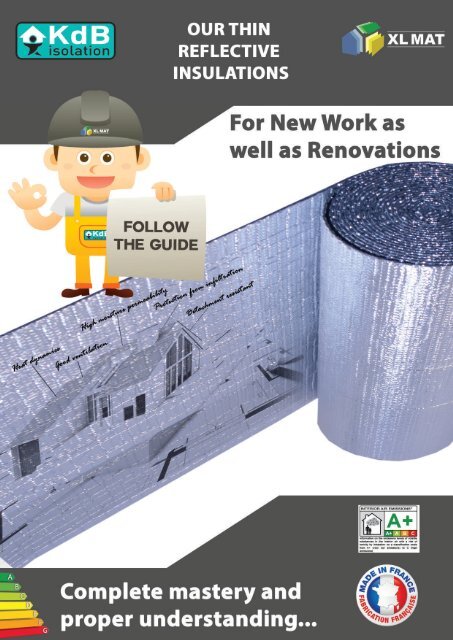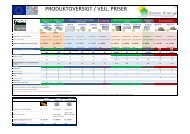Guid pose anglais
Create successful ePaper yourself
Turn your PDF publications into a flip-book with our unique Google optimized e-Paper software.
Advice prior to installing<br />
Thin Reflective Insulation (TRI)<br />
It essential that the condition of the base structures be checked before installation. After<br />
insulation has been installed, it must be checked to ensure it is in proper condition:<br />
No signs of moisture, mould or rotting.<br />
No inappropriate entry of air (e.g. unused pipe).<br />
No crushed spots, and insulation<br />
completely fills the place where it is installed.<br />
The covering must be rain<br />
proof,<br />
Roof frame components must<br />
be in good condition and not<br />
moist,<br />
They should be cleared of<br />
anything that could perforate the<br />
insulation:<br />
nails, electric cables, etc.<br />
If a subjacent roof screen is<br />
installed or maintained, best<br />
practices of the trade must be<br />
followed, particularly concerning<br />
ventilation of the air space under<br />
the roofing, as needed and according<br />
to applicable provisions:<br />
Homologation,<br />
DTU series 40,<br />
E-Book of the CSTB 3651-2<br />
Although subjacent roof screens are air and water proof, they are no substitute<br />
for a tarp, be sure to protect you work site from bad weather.
Contents<br />
Ventilation<br />
Installation of TRI as a subjacent roof screen with<br />
existing 3D insulation<br />
Installation of TRI as a subjacent roof screen alone<br />
Installation of TRI as a subjacent roof screen alone<br />
under zinc and steel panels<br />
Technical details and special aspects<br />
Installation of roof window and chimney flue<br />
Installation of TRI in a vertical wall<br />
Installation of TRI in a roof slope<br />
Installation of TRI and a subjacent roof reflective screen<br />
TRI XL MAT / KdB product line<br />
Tips and Tricks<br />
General information<br />
. . . . . . . . . . . . . . . . . . .<br />
. . . . . . . . . . . . . . . . . . .<br />
. . . . . . . . . . . . . . . . . . .<br />
. . . . . . . . . . . . . . . . . . .<br />
. . . . . . . . . . . . . . . . . . .<br />
. . . . . . . . . . . . . . . . . . .<br />
. . . . . . . . . . . . . . . . . . .<br />
. . . . . . . . . . . . . . . . . . .<br />
. . . . . . . . . . . . . . . . . . .<br />
. . . . . . . . . . . . . . . . . . .<br />
. . . . . . . . . . . . . . . . . . .<br />
. . . . . . . . . . . . . . . . . . .<br />
page 4<br />
page 5<br />
page 6<br />
page 7<br />
page 8<br />
page 9<br />
page 10<br />
page 11<br />
page 12<br />
page 13<br />
page 14<br />
page 15
Ventilation is a key factor for<br />
your health and a healthy home<br />
Air extraction:<br />
Either through the roof ridge or<br />
via vent caps,<br />
Or by ventilation tiles<br />
Air entry:<br />
Either by ventilation tiles,<br />
Or via eave spaces<br />
The air space ventilated between the surface of the insulation, of whatever type, and the<br />
under side of the roofing must be at least 40 mm in depth (DTU series 40). In order to obtain this<br />
volume, the counter-battens must be 27 mm thick and the battens 14-27 mm thick, depending<br />
on the type of roofing.<br />
Placement of tiles with clay vent or<br />
mushroom-shaped PVC vent on one<br />
roof slope<br />
Top unit<br />
TRI as a subjacent roof screen:<br />
AIRFLEX or PERMOVAP<br />
or XL’AIR or XL’TOP5+<br />
Bottom unit<br />
Ventilation of insulated and<br />
uninsulated crawl spaces and<br />
attics<br />
Whether a crawl space is insulated or<br />
uninsulated, it absolutely must be<br />
ventilated.<br />
The builder is responsible for informing<br />
the customer about the risks involved in<br />
not having mechanical ventilation, and for<br />
recommending a suitable solution.<br />
. .<br />
.<br />
Tile with socket equipped<br />
with an adapter on the<br />
under side<br />
.<br />
Rafter<br />
Adhesive strip<br />
Raised side seal<br />
around the flue
Installation of TRI as a subjacent roof<br />
screen with existing 3D insulation<br />
HPV subjacent roof<br />
screen<br />
Slate or tile roofing<br />
HPV Screen:<br />
Continuous<br />
installation of<br />
the roof ridge<br />
27 mm batten<br />
.<br />
.<br />
.<br />
.<br />
.<br />
.<br />
PERMOVAP or<br />
XL’AIR or XL’TOP5+<br />
Purlin<br />
Hanger and metal framing<br />
Rafter<br />
.<br />
.<br />
.<br />
27 mm counter-batten<br />
27 mm batten<br />
3D insulation<br />
Waterproof<br />
roof screen<br />
subjacent<br />
- Ventilation mandatory on the<br />
under side<br />
- 50 mm minimum on both sides of<br />
the roof ridge<br />
.<br />
Ventilation<br />
along side<br />
of drip edge<br />
Edge board<br />
Air entry with insect<br />
screen compliant with DTU<br />
.<br />
Ventilated air space<br />
Ventilation on<br />
the under side<br />
.<br />
.<br />
.<br />
.<br />
.<br />
.<br />
.<br />
.<br />
.<br />
.<br />
.<br />
.<br />
..<br />
27 mm batten<br />
Counter-batten<br />
TRI as a subjacent roof<br />
screen:<br />
AIRFLEX<br />
3D insulation<br />
Rafter<br />
Unventilated air space<br />
TRI as<br />
moisture-barrier supplement:<br />
Airflex or Expert 50 or<br />
Xlaine or 15 PRO or<br />
ISO 55<br />
Mounting plate<br />
Finishing panel<br />
Finished wall complex
Installation of TRI as a subjacent<br />
roof screen alone<br />
Installation of<br />
EXPERT 70<br />
.<br />
Batten<br />
.<br />
EXPERT 70<br />
.<br />
.<br />
.<br />
.<br />
Ceiling mounting rail<br />
Rafter<br />
Plaster board<br />
Continuous installation of TRI with option to add<br />
an HPV subjacent roof screen such as Permovap,<br />
XL AIR or XL TOP 5+ (see installation on page 12)
Installation of TRI alone as a subjacent<br />
roof under zinc and steel panels<br />
Installation on rafters under zinc<br />
panels with upright joints<br />
Zinc roofing with upright joints<br />
.<br />
.<br />
Filler slat or not<br />
Top ventilation<br />
ventilation tile<br />
Purlin<br />
. .<br />
.<br />
60 mm ventilated air space<br />
60 mm furring strip<br />
.<br />
.<br />
Rafter<br />
. .<br />
.<br />
Finishing panel<br />
Hanger and metal framing<br />
AIRFLEX * or PERMOVAP or<br />
XL’AIR or XL’TOP5+<br />
Installation on rafters under steel<br />
panels or ribbed sheeting<br />
* Ventilation mandatory on the under side<br />
* Opening of 50 mm minimum on both sides of the roof ridge<br />
* According to the standard DTU 40.41, Article 3.52, the ventilated air space<br />
must be 40 mm for a roof with a roof slope of less than 12 m and 60 mm with a<br />
slope of more than 12 m.<br />
.<br />
.<br />
Steel panel<br />
Top ventilation tile<br />
Purlin<br />
.<br />
.<br />
.<br />
.<br />
Ribbed sheeting<br />
80 mm ventilated air space<br />
Rafter<br />
Finishing panel<br />
. .<br />
.<br />
.<br />
80 mm furring strip<br />
Hanger and metal framing<br />
AIRFLEX * or PERMOVAP or<br />
XL’AIR or XL’TOP5+
Special technical details<br />
Making a<br />
roof gulley<br />
2<br />
Batten<br />
.<br />
.<br />
Ventilated air space<br />
8 cm min<br />
8 cm min<br />
.<br />
.<br />
.<br />
.<br />
. .<br />
Zinc roof gulley<br />
18 mm slat<br />
18 mm batten for aeration<br />
Counter-batten<br />
Rafter<br />
TRI as subjacent roof<br />
screen:<br />
AIRFLEX or PERMOVAP or<br />
XL’AIR or XL’TOP5+<br />
.<br />
Purlin<br />
Finishing on side<br />
wall with gables<br />
Never make the<br />
sealing joint at the<br />
bottom of the gulley<br />
Zinc flashing with leading edge<br />
Tile or slate roofing<br />
Batten<br />
27 mm counter-batten<br />
Ventilated air space<br />
.<br />
.<br />
.<br />
.<br />
.<br />
.<br />
.<br />
.<br />
Rafter<br />
Ventilated under side<br />
TRI as a subjacent roof<br />
screen:<br />
AIRFLEX or PERMOVAP<br />
or XL’AIR or XL’TOP5+<br />
Purlin<br />
.<br />
.<br />
.<br />
.<br />
Finishing panel<br />
3D insulation<br />
TRI as<br />
moisture-barrier<br />
supplement:<br />
Airflex or Expert 50 or<br />
Xlaine or 15 PRO or<br />
ISO 55
Installation of roof window<br />
and chimney flue<br />
Batten<br />
Counter-batten<br />
2 furring strips: 27 x 27 mm<br />
Rainwater<br />
run-off lip<br />
.<br />
. . .<br />
.<br />
Tile or slate roofing<br />
Connection to roof<br />
frame<br />
.<br />
.<br />
.<br />
.<br />
Stringer<br />
Rafter<br />
Mounting bracket<br />
Joining adhesive<br />
width: 100 mm<br />
Subjacent roof screen<br />
.<br />
.<br />
.<br />
.<br />
Roof frame<br />
Rafter<br />
Purlin<br />
Counter-batten<br />
.<br />
.<br />
.<br />
.<br />
.<br />
.<br />
Adhesive<br />
The subjacent roof screen turn-back<br />
on the frame must be stapled<br />
* Ventilation mandatory on the under side<br />
* Opening of 50 mm minimum<br />
on both sides of the roof ridge<br />
Batten depending<br />
on type of roofing<br />
AIRFLEX * or PERMOVAP<br />
or XL’AIR or XL’TOP5+<br />
Fire protection<br />
Allowance for<br />
chimneys/smoke flues<br />
AIRFLEX* or PERMOVAP or<br />
XL’AIR or XL’TOP5+<br />
27 mm counter-batten<br />
14 x 27 mm batten<br />
depending on type<br />
of roofing<br />
.<br />
.<br />
.<br />
.<br />
.<br />
Safety<br />
distance<br />
Insulation<br />
laid first<br />
Adhesive<br />
.<br />
.<br />
Concrete filler<br />
The standard NF DTU 24.2 stipulates<br />
a fire safety distance that<br />
depends on the type of chimney/<br />
smoke flue and its temperature<br />
classification. One should follow all of these<br />
specifications in every aspect for fire<br />
safety distances.
Installation of TRI in a vertical wall<br />
interior and exterior<br />
The system using a metal framework<br />
allows one to re-plumb an old wall<br />
INTERIOR SYSTEM<br />
.<br />
.<br />
Turn-back of TRI on the<br />
metal framework rail<br />
20 x 25 x 40 mm furring strip<br />
Metal framework<br />
(risers and cross-bars)<br />
.<br />
.<br />
.<br />
.<br />
EXPERT 50 or ISO55<br />
or EXPERT 70 or 15 PRO<br />
or XLAINE or AIRFLEX<br />
Ambient air space<br />
Finishing panel<br />
.<br />
Wall<br />
.<br />
Principle of using discontinuous furring strips to provide ventilation of<br />
the air space between the exterior wall and the reflective insulation<br />
EXTERIOR SYSTEM (HPV TRI)<br />
.<br />
Bird<br />
guard<br />
.<br />
.<br />
.<br />
Rodent<br />
guard<br />
20 x 25 x 40 mm furring strip
Installation of TRI in a roof slope<br />
Installation alone<br />
O<br />
Ventilated air spaces<br />
.<br />
Slate or tile roofing<br />
.<br />
Purlin<br />
Rafter<br />
.<br />
Battens<br />
Metal framework<br />
.<br />
.<br />
.<br />
Finishing panel<br />
(plaster panel)<br />
.<br />
.<br />
.<br />
.<br />
Unventilated air space<br />
EXPERT 70<br />
(also serves as sealing film)<br />
Recommendation for<br />
installation:<br />
- Staple every 200 mm<br />
and seal with an adhesive.<br />
- 100 mm minimum layer<br />
overlap<br />
As a supplement to<br />
3D insulation<br />
Battens<br />
Rafter<br />
Slate or tile roofing .<br />
Ventilated air spaces<br />
.<br />
3D insulation<br />
80 mm (standard 36 max)<br />
. XLAINE or AIRFLEX or<br />
. EXPERT 50 or 15 PRO or ISO 55<br />
. . (also serves as sealing film)<br />
.<br />
Unventilated air space<br />
.<br />
.<br />
.<br />
.<br />
Purlin<br />
Metal framework<br />
Finishing panel<br />
(plaster panel)<br />
SIXBOX hangers to ensure seal<br />
The 3D insulation must not have a moisture barrier, if it does, the barrier should be cut<br />
into. Recommendation for installation:<br />
- Staple every 200 mm and seal with an adhesive.<br />
- 100 mm minimum layer overlap
Installation of TRI and<br />
a reflective subjacent roof screen<br />
Continuous installation of TRI<br />
and subjacent roof screen<br />
.<br />
.<br />
.<br />
Counter-batten<br />
Batten<br />
Subjacent roof screen<br />
.<br />
.<br />
Metallic adhesive<br />
Reflective insulation<br />
Ceiling mounting rail<br />
.<br />
Rafter<br />
. .<br />
Plaster board<br />
Moisture-permeable subjacent roof screens: PERMOVAP, XL’AIR, XL TOP5+<br />
THIN REFLECTIVE INSULATION (TRI): EXPERT 70, EXPERT 50, ISO 55, 15 PRO, XLAINE<br />
.<br />
.<br />
.<br />
.<br />
.<br />
Reflective insulation<br />
HPV Subjacent roof screen<br />
Rafter<br />
Counter-batten<br />
Plaster board<br />
Continuous installation<br />
of subjacent roof screen<br />
with closing at the roof<br />
ridge line<br />
.<br />
Supporting rail for<br />
plaster board<br />
In case of holes drilled and at the ends of layers or Thin<br />
Reflective Insulation, be sure to create a complete seal using<br />
Kdb/XL MAT metallic 100 25 tape
Product line<br />
XL MAT - KdB
Tips and Tricks for the installation of<br />
THIN REFLECTIVE INSULATION<br />
Start installation at the top of the roof slope or vertical wall:<br />
Use a few staples or double-sided tape to<br />
temporarily hold the product in place before attaching the first rail.<br />
Type of wall mounting staples:<br />
Dimension: 18 mm minimum.<br />
This type of staples requires the use of a staple gun<br />
(electric or pneumatic).<br />
For cutting, use:<br />
Scissors with blades longer than 20 cm.<br />
Pre-assemble all the adjacent sections on the ground using<br />
the built-in adhesive.<br />
Thin Reflective Insulation can be installed on the inner side (heated side)<br />
of a new structure, or existing structure between previously installed<br />
insulation, if any, and the interior wall or ceiling.<br />
Thin Reflective Insulation can be installed with one or two air spaces<br />
on either side, regardless of the type of roof framing:<br />
Classic framing, or<br />
Industrial framing,<br />
Raised trusses, in new or existing structures.<br />
The creation of air spaces adjacent to thin reflective insulation<br />
requires the installation of:<br />
Either a wood frame comprised of raised furring strips greater<br />
than or equal to 40 mm and treated with a preservative that is<br />
compatible with the other materials present,<br />
Or a metal frame comprised of rails U/40/50/40 and risers<br />
C/40/48/40, used to build walls made with plaster panels (see<br />
DTU 25.41 and standard NF P 72-203-1).
General information<br />
Nails and screws can be used to install our thin reflective insulation<br />
and subjacent roof screens.<br />
In the case of interior finishing with plaster caulking or other<br />
moisture-producing materials, plan for ventilation and maximum<br />
airing out over several days.<br />
For structures at altitudes of more than 900 m, please refer to the<br />
special regulations for mountains.<br />
100 mm minimum overlap of widths.<br />
As with all aluminium products, AIRFLEX must have an earthing<br />
connection for each panel.<br />
When installing Airflex as a subjacent roof screen, one must leave<br />
an opening at the roof ridge line and gutter line.<br />
Do not install lighting that emits high heat levels in ceilings or false<br />
ceilings.<br />
Store Thin Reflective Insulation and subjacent roof screens indoors<br />
in both summer and winter.<br />
In compliance with regulations, Thin Reflective Insulation must not<br />
be visible in inhabitable rooms.<br />
Thin Reflective Insulation must not be perforated by mounting legs<br />
or hangers.




